Plan for Unexpected Wedding Dress Expenses: A Comprehensive Guide
Understanding Unexpected Wedding Dress Expenses
Weddings are beautiful celebrations filled with love and joy. However, as many couples quickly learn, planning a wedding can also come with unexpected costs. One of the most significant expenses in wedding planning is the wedding dress. While it’s easy to get caught up in the excitement of finding the perfect gown, it’s crucial to be prepared for the unforeseen financial challenges that may arise. This article will guide you through the various unexpected wedding dress expenses and how to plan for them effectively.
The Cost of the Dress Itself
The most obvious expense is the dress itself. Depending on the designer, style, and fabric, wedding dresses can range from a few hundred to several thousand dollars. To avoid surprise expenses, it’s essential to establish an estimated budget before you start shopping for your dress. Consider doing some research on average prices in your area. For example, in the United States, an average wedding dress might cost around $1,500. However, it is important to remember that high-end designers or custom gowns can exceed $5,000.
Additional Costs Beyond the Dress
Many brides fail to account for the additional costs associated with buying a wedding dress. Here are some common unexpected expenses to consider:
| Expense | Estimated Cost |
| Alterations | $150 - $600 |
| Accessories (Veil, Shoes, Jewelry) | $100 - $500 |
| Cleaning and Preservation | $150 - $300 |
| Shipping (if ordering online) | $30 - $100 |
| Emergency repairs | $50 - $200 |
Each of these costs can add up quickly, leading to financial stress. Thus, it is imperative to allocate extra funds for these potential additional expenses when planning your wedding dress budget.
Understanding Alteration Costs
One of the most commonly overlooked costs is dress alterations. Almost every bride will need her dress altered to ensure a perfect fit. This can include hemming the dress, adjusting the bustline, or adding straps. Alteration costs can vary based on the complexity of the modifications and the seamstress's experience. Always factor in these potential expenses when budget planning.
Accessories: The Icing on the Cake
Accessories play a vital role in completing the wedding day look. Many brides underestimate the cost of essential accessories such as veils, shoes, and jewelry. It is recommended that brides set aside a specific budget for accessories to avoid overspending. Aim for approximately 10-30% of your dress budget for accessories.
Cleaning and Preservation of the Dress
After the big day, most brides will want to clean and preserve their wedding dress to keep it in pristine condition. This can be a sizeable expense, often ranging from $150 to $300, depending on the fabric and complexity of the dress. Research local cleaning services that specialize in wedding dresses to ensure your gown is preserved properly.
The Impact of Online Shopping
In recent years, many brides have turned to online retailers to find their wedding dresses. While this can save you money, it’s essential to consider potential shipping costs and return fees. If you're ordering from an international retailer, customs fees might also apply. Always read the return policy thoroughly to avoid unexpected expenses.
Emergency Repairs: Preparing for the Unexpected
Despite meticulous planning, things can go wrong on your wedding day, such as a broken zipper or a torn seam. Setting aside a budget for emergency repairs can alleviate stress on your special day. Discuss emergency repair options with your seamstress and factor the costs into your overall budget.
Tips for Budgeting Unexpected Wedding Dress Expenses
Now that we’ve discussed potential unexpected wedding dress expenses, here are tips to effectively budget for them:
1. Create a Detailed Budget
Start by outlining all the known expenses for your wedding dress, including the dress, alterations, and accessories. Then add a buffer of at least 20-30% for unexpected expenses.
2. Do Your Research
Spend some time researching local boutiques and online options. Look for reviews and price comparisons to get an accurate picture of what to expect regarding costs.
3. Set a Strict Dress Budget
Categorize your purchases into essentials and extras. By prioritizing critical items first, you can better manage your budget and avoid overspending.
4. Keep an Eye on Sales
Many bridal shops have seasonal sales, which can significantly reduce the price of a wedding dress. If possible, shop during these times to save on unexpected expenses.
5. Communicate with Your Vendors
Keep an open line of communication with your dress vendor, seamstress, and other relevant parties. This will help you stay informed about any additional costs and ensure you’re prepared.

Conclusion
Planning for unexpected wedding dress expenses is crucial for any bride-to-be. By being aware of potential additional costs, you can avoid last-minute financial stress. Always create a detailed budget that includes not only the dress but also alterations, accessories, cleaning, and emergency repairs. Remember, while your wedding dress is just one aspect of your wedding, it is undoubtedly a cherished one. Planning ahead will make your wedding day all the more enjoyable.
In summary, being informed and prepared can make your journey to finding the perfect wedding dress much smoother. Establish a budget, conduct thorough research, and communicate with your vendors. This proactive approach ensures that your wedding dress remains a symbol of joy, rather than an unexpected financial burden.